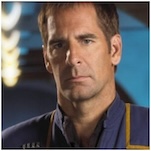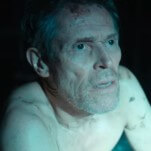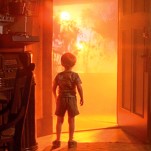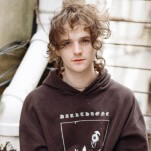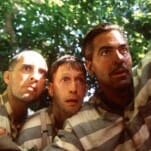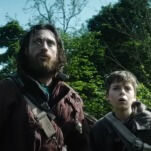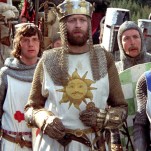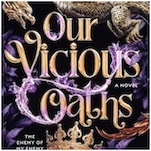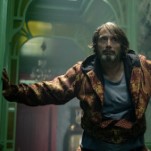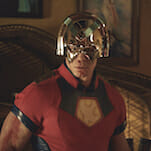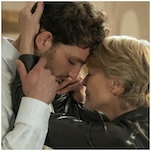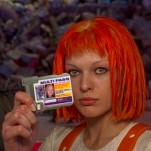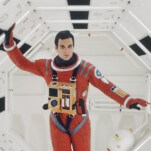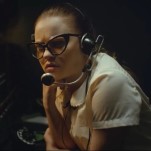Strange Saint Nick: 10 of the Weirdest Santa Claus Movies
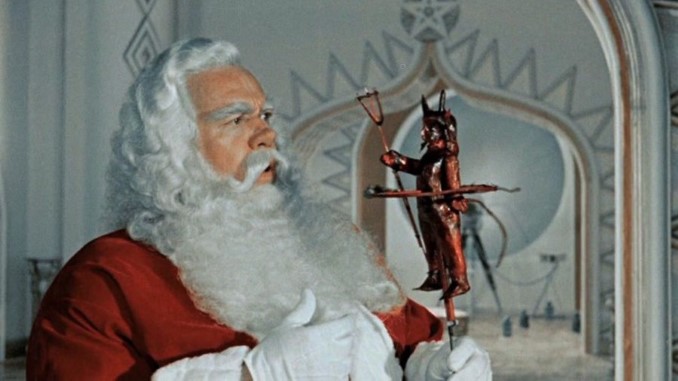
It’s a common refrain to joke about how casually we as a society have accepted—and so deeply integrated—the myth of Santa Claus into the Christmas season, given just how strange the very concept of such a man (or Christmas demigod?) really is. The jolly, robed magic man who keeps yearly tabs on children and sneaks into your home at night to drop off packages does sound disconcerting when put in a certain light. Yet most Santa-centric media is determined to frame him as wholesome, comforting, and entirely unremarkable in his benevolence.
It’s a select few films that depict him within the context of what he really is: a strange, inexplicable being, whose true relationship to us humans is as mysterious as it is baffling. Whether it’s through his own strange characterizations or the surreal worlds built around him, these movies serve as an antidote to the polished, commercialized Kris Kringle we’re so often sold. Santa is bizarre, and these films revel in that fact.
1. Santa Claus (1959)
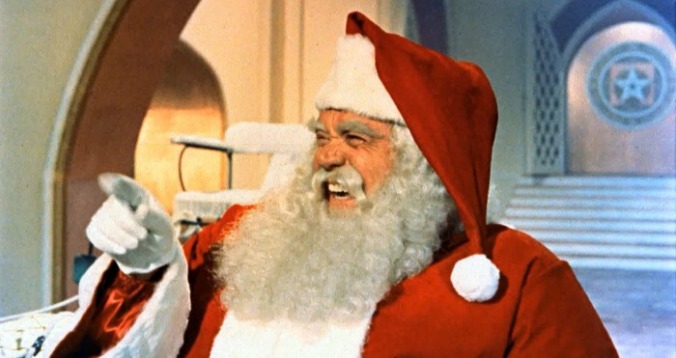
The weirdness of this Santa is more aptly reflected in this film’s alternative title: Santa Claus vs. The Devil. And even that only scratches the surface of what this 1959 Mexican fantasy fable from director René Cardona has to offer—an even more accurate title would be Santa Claus, Merlin the Wizard, and Santa’s Child Helpers of Various Nationalities vs. The Devil’s Minion Named Pitch. This version of Santa (played by José Elías Moreno) resides in a castle in space, where we’re introduced to him and his young assistants on Christmas Eve in a 10-minute sequence that sees him playing the organ while introducing children from around the world as they sing culturally themed songs. Things escalate when Santa learns that Lucifer himself has sent a minion—Pitch (José Luis Aguirre)—to Earth to corrupt children and lead them astray, including Lupita (Lupita Quezadas), a poor girl whose resistance to Pitch’s temptations runs parallel to Santa’s efforts to save Christmas. At its core, this isn’t much more than a dated morality tale about the triumph of virtue over sin, told through the lens of Christmas purity clashing with demonic corruption. But it’s all of the odd story elements and production details that make it truly strange: Merlin and Santa living together in space; a giant pair of lips in Santa’s equipment room that functions as a magical hot mic for eavesdropping on Earth; an eerie dream sequence where Pitch tries to tempt Lupita with creepy, dancing dolls; and the sheer oddity of Santa matching wits with a devilish figure straight out of classical depictions, complete with crimson skin and horns. This film was made famous in the weird movie canon by Mystery Science Theater 3000, but the surreal effect of watching it has yet to lose its luster.
2. Santa Claus Conquers the Martians (1964)
Santa Claus Conquers the Martians (another MST3K veteran) is a 1964 holiday sci-fi mashup that regularly appears on lists of the worst films of all time—perhaps deservedly so, even if overall it’s rather innocuous. It is weird though, with an impossible-to-mask low budget and situated within a wholly nuts narrative about a group of Martians that kidnap Santa Claus (John Call) to bring Christmas cheer to the alien inhabitants of Mars. Alas, this version of Santa’s cheer mostly manifests in awkward, occasionally infectious maniacal laughter as he regularly puts kids through what is essentially a terrible stand-up act. Meanwhile, a Martian malcontent plots to kill him, deeming Santa a threat to their rigid society, upping the ante in a movie that’s already perfectly bizarre. There’s plenty here that makes this work as pure loony novelty—I have to mention the rousing festive theme song that bookends the film—but Call ties the whole thing together with his delightfully strange interpretation of Claus that’s simultaneously hearty and creepy, often turning this simple genre blend into something distinctly more surreal. Even still, you’re probably better off just watching this clip.
3. Rudolph the Red-Nosed Reindeer (1964)
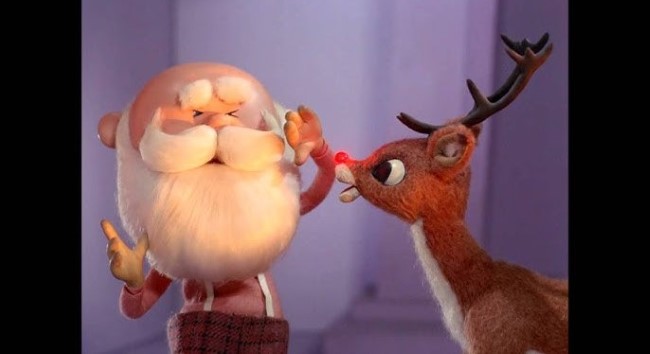
For many families, the Arthur Rankin Jr. and Jules Bass-produced Rudolph the Red-Nosed Reindeer is a holiday staple not typically expected on a list of aberrant Santa interpretations. But the Santa of this special (voiced by Stan Francis) is shockingly callous, more akin to a stringent, harsh corporation executive than a merry bearer of magic and gifts. He oversees an exacting, almost degrading process to select the elite reindeer who will lead his sleigh, and when he discovers Rudolph has been “deceiving” him by hiding his glowing nose, Santa essentially banishes him, telling Donner he never wants to see Rudolph again. He also acts as the directing head of a toy assembly line managed by a tyrannical elf, disregards his workers when they perform a song for him, won’t eat Mrs. Claus’s food meant to fatten him up, and exiles imperfect toys to the infamous Island of Misfit Toys. He only has a change of heart once Rudolph proves himself useful—otherwise, his differences incite unrelenting cruelty. The mean streak of Rudolph the Red-Nosed Reindeer is crystallized in its ending when an elf sends a flightless toy bird plummeting to its death. Santa and his underlings make the North Pole look like an authoritarian nightmare where you must naturally conform to established societal conventions—or else.
4. Santa and the Ice Cream Bunny (1972)
It’s hard to know where to begin with the rendition of Santa as seen in Santa and the Ice Cream Bunny. This Z-grade, no-budget oddity from director Richard Winer sees Santa (Jay Ripley) stranded on a Florida beach after his sleigh crash-lands, now stuck and unable to resume flight. Why Santa is flying around just days before Christmas Eve, and how a magical figure capable of visiting every child’s home in one night can’t get his sleigh unstuck from some sand, are questions the film doesn’t bother to answer. Instead, we watch Santa call on the local Floridian children via telepathy to help him escape the sand. They, in turn, enlist the help of farm animals and a man in a gorilla suit to no avail. If you’re wondering how this flimsy premise stretches to a 90-minute runtime, the answer is simple: it doesn’t. About 20 minutes in, the movie pivots to an entirely different, previously released production by Barry Mahon—either Thumbelina or Jack and the Beanstalk, depending on the version you watch. These fairy tales, framed as Santa’s inspirational stories for the kids, dominate the runtime but are just as cheap and lifeless as the frame story itself and made insulting by the fact that the whole film’s existence is a blatant ploy to shove these previous movies onto viewers. Topping it all off is a comically uninterested performance from Ripley as Santa and the appearance of the nightmarish titular Ice Cream Bunny, whose random insertion somehow saves the day. (Who is the Ice Cream Bunny? Some questions we take to the grave.) The result is a fever dream of a film that stretches the definition of what qualifies as a Christmas movie—or even just a movie in general.
5. Christmas Evil (1980)
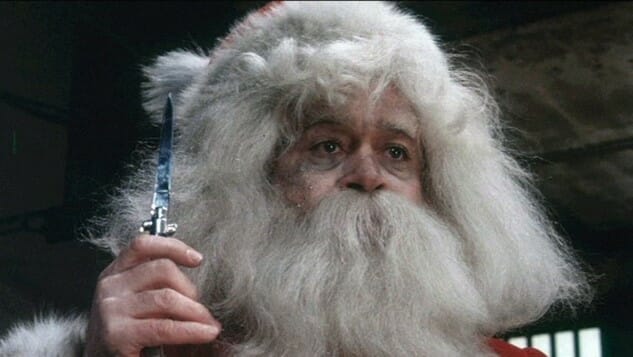
Christmas Evil posits itself as a holiday horror—a festive riff on Halloween where Michael Myers’ adolescent trauma is swapped for that of Harry Stadling, a boy who becomes a murderous Santa Claus played by Brandon Maggart in adulthood. How, you ask? He finds out the jolly, magic old man himself is fake after he sees his mom and dad getting it on in the wee hours of Christmas morning, his father outfitted in full Santa garb. It’s more directly perverse than the suggestive stunted adolescent development of Myers, and operates in the more low-fi, seedy register that you would expect from naturalistic sorts of 70s dramas—that is, until an out-of-nowhere fantastical ending that further subverts and complicates the whole thing. But for most of the movie, Christmas Evil is commonly associated with Taxi Driver, with Harry leaning fully into his yuletide Travis Bickle persona. Maggart echoes that famous De Niro performance with effective, unnerving success as he dons the red coat and beard seeking retribution against a corrupt society (while obsessively spying on children to judge their naughty or nice status). Less a traditional slasher and more of a weirdo exploitation film, Christmas Evil pits the joy of the holiday season against the bitter disillusionment of a man warped by delusion.
6. The Life and Adventures of Santa Claus (1985)
Another Rankin/Bass production, The Life and Adventures of Santa Claus is a more obscure stop-motion holiday special compared to the duo’s better-known classics. It’s also completely whacked out, detailing the origin of Santa Claus (Earl Hammond) through a mashup of epic mythology, high fantasy, and He-Man and the Masters of the Universe-style action. This Santa’s beginnings are framed as a saga of cosmic significance, featuring round-table tribunals led by a Gandalf-like figure discussing whether or not Santa deserves immortality and wizards wielding magic battle axes that shoot lasers at demons determined to sabotage Santa’s plans for delivering toys to children. Here, the plight of Santa Claus is recontextualized as an epic battle between good and evil. As a mortal born to an undying society, Santa grapples with the philosophical weight of humanity’s struggles upon seeing the abject poverty of Earth: “What is man’s use? Why is he here? Why is he born at all?” The Life and Adventures of Santa Claus refuses to simply detail how Santa found a home for his toy factory and assembled his elves in the North Pole: It puts him head-to-head with death and pushes him to sustain his goodness against malevolence. If it were up to me, this would probably act as the default canon for Santa Claus for children worldwide—it’s honestly pretty sick.
7. Santa Claus: The Movie (1985)
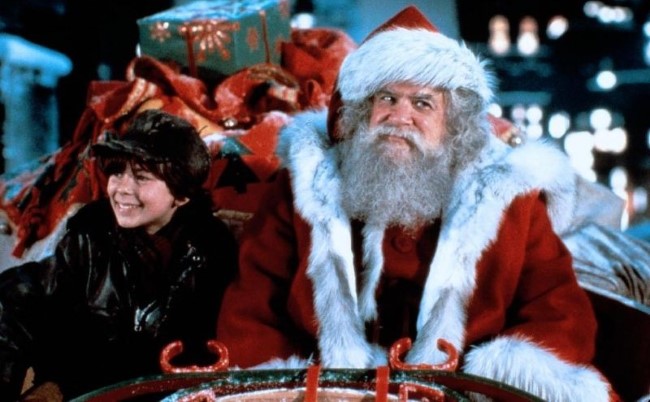
To be fair, Santa Claus: The Movie features a pretty typical portrayal of Santa, played here by David Huddleston as the traditional, jolly, and warm old Saint Nick you expect. It’s the movie around him that’s a little strange, and ends up partially tinging this Santa with some residual peculiarity. For one, this movie introduced the concept of death being an essential facet of Santa’s creation story nearly a decade before The Santa Clause. Here, it’s perhaps even more disconcerting, as the role of Santa is posited as a prophesied inevitability for this one man’s afterlife, following a cosmic mandate beyond his control. He meets a wise old sage elf played by Burgess Meredith (in the film for all of a single scene), who tells Santa that his mission on Christmas Eve will be perceived as an “endless night” to him until all the children of the world have received their presents. The true conflict doesn’t even appear until an hour into this 100-minute movie when John Lithgow steps in as a scheming corporate executive trying to oust Santa and become the pioneer of his own holiday: Christmas 2. Naturally, his plans eventually include kidnapping and gagging a homeless orphan boy. If nothing else, this movie may be worth a watch for a Lithgow performance that’s far too committed given the quality of the material at hand, and his character’s surprisingly grisly fate.
8. Rudolph the Red-Nosed Reindeer and The Island of Misfit Toys (2001)
Did you know there was a CG-animated direct sequel to the 1964 Rudolph the Red-Nosed Reindeer featuring the voice talents of Richard Dreyfuss, Rick Moranis, and Jamie Lee Curtis as a weirdly sensual queen hippopotamus? Rudolph the Red-Nosed Reindeer and the Island of Misfit Toys is some classic lazy cash-in material, replacing the original special’s memorable stop-motion animation with cheap-looking-even-for-the-time CGI. This time around, Rudolph (Kathleen Barr) is grappling with celebrity burnout, his once-derided nose now a different source of dehumanization as the North Pole treats him like a sideshow act to show off whenever they want to see it glow. Meanwhile, Santa (Garry Chalk) and the gang are dealing with the Toy Taker (Moranis), a mysterious villain snatching up Santa’s toys whose face-obscuring disguise kind of makes him look like the Garo enemies from The Legend of Zelda: Majora’s Mask. You could take umbrage with a lot in this film, but I was most perturbed by Santa’s lack of growth from the original entry. He continues to let the other reindeer treat Rudolph any kind of way, and he’s still perfectly content to relegate “defective” toys to The Island of Misfit Toys—reverses of his two main arcs in the first special. No lessons were learned—Santa’s redemption was false!
9. The Chronicles of Narnia: The Lion, The Witch, and the Wardrobe (2005)
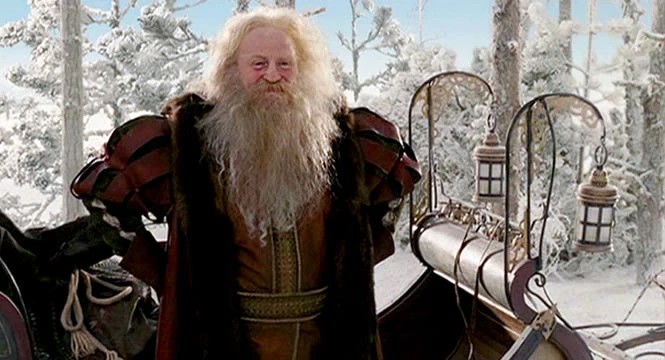
There are plenty of fantastical creatures to be found within The Chronicles of Narnia: The Lion, The Witch, and The Wardrobe, the first big-budget film adaptation of C.S. Lewis’s series of high-fantasy children’s adventure novels: fauns, witches, centaurs, giants, and Christ-like lions. But somehow the most unusual encounter the Pevensie children have in this world is with Santa Claus, referred to here as Father Christmas (James Cosmo). The scene is admittedly made even more uncanny by the CGI talking beavers watching on in delight, but something about this world of mythic beasts also being home to the likes of modern holiday figures obscures the in-narrative reality strangely. Then again, the Christian undertones of the material may justify the inclusion of the most all-encompassing holiday of the religion, but then that’s undercut by the fact that this Santa acts as a weapons dealer to these children, bestowing equipment such as a bow and arrow and a broadsword and shield to fight in a magical war. He functions as a surprise pit stop for the children who stumble upon him in the woods, and then he rides off never to be seen again. The scene is played with enough sincerity to come off as no more unusual than anything else in Narnia but other creatures seem to exist with a more connective overarching context of fantasy—a 2-minute scene where Santa hands out combat gear for three children to go to war ends up feeling bizarre.
10. Elf Bowling the Movie: The Great North Pole Elf Strike (2006)
There’s something for everyone in this world, I guess—even those yearning for a feature-length expansion of the dense, complicated lore suggested by the 1998 Windows computer game Elf Bowling. In the game, you play as Santa, bowling with his elves as live pins. That’s pretty much it. Nevertheless, Elf Bowling the Movie finds ample opportunity to explore this exceedingly simple concept in increasingly inane ways, all portrayed through that strangely textured form of cheap CGI animation that you find in terrible movie cult classics like Foodfight! Santa’s backstory here reimagines him as a pirate of all things, manning a ship alongside his conniving brother Dingle (inexplicably played by famed voice actors Joe Alaskey and Tom Kenny, respectively). Eventually, he’s thrown overboard and washes up at the North Pole, where he takes heed of the elves’ need for a leader, donning the red coat and hat to become the Santa you know and love. His problems begin with an elf workforce that starts feeling exploited, eventually leading to a labor strike. Dingle schemes to take control of Christmas for himself, manipulating the ideals of working-class solidarity amongst the elves to position himself as a populist leader promising simple fixes to their problems. This socio-economic conflict is peppered with the kind of ludicrous nonsense you’d expect from a movie like this, including Tom Kenny belting out a tune about the merits of slavery and a climactic battle for control over Christmas waged over a game of the titular Elf Bowling. Nothing screams Christmas like pirates, political allegory, and bowling, all in eye-strainingly awful animation.
Trace Sauveur is a writer based in Austin, TX, where he primarily contributes to The Austin Chronicle. He loves David Lynch, John Carpenter, the Fast & Furious movies, and all the same bands he listened to in high school. He is @tracesauveur on Twitter where you can allow his thoughts to contaminate your feed.


